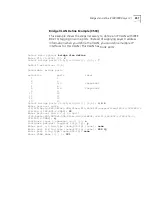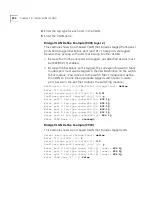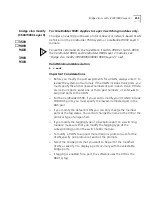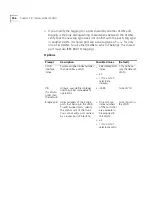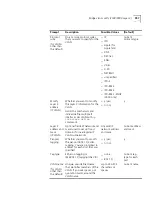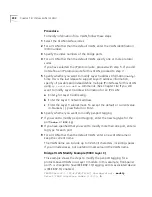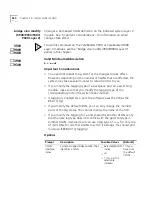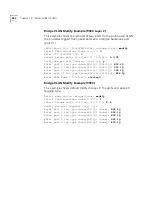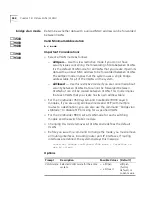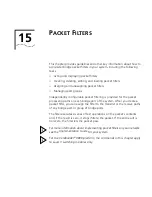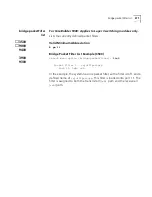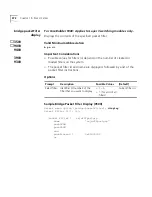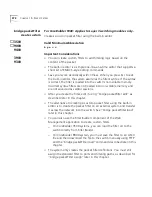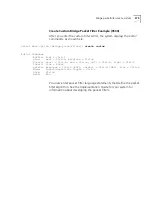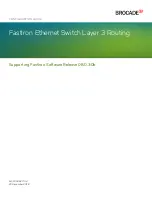
364
C
HAPTER
14: V
IRTUAL
LAN
S
(VLAN
S
)
✓
3500
✓
9000
✓
9400
✓
3900
✓
9300
bridge vlan mode
Determines whether data with a unicast MAC address can be forwarded
between VLANs.
Valid Minimum Abbreviation
b v mode
Important Considerations
■
Select a VLAN mode as follows:
■
allOpen
— Use this less restrictive mode if you do not have
security issues concerning the forwarding of data between VLANs.
It is the default VLAN mode for all VLANs that you create. It permits
data with a unicast MAC address to be forwarded between VLANs.
The allOpen mode implies that the system uses a single bridge
address table for all of the VLANs on the system.
■
allClosed
— Use this restrictive mode if you are concerned about
security between VLANs. Data cannot be forwarded between
VLANs but can still be routed between VLANs. This mode implies
that each VLAN that you create has its own address table.
■
For the CoreBuilder 3500 system and CoreBuilder 9000 Layer 3
modules, if you are using allClosed mode and STP (with multiple
routes to a destination), you can also use the command “bridge vlan
stpMode” to disable STP blocking for a specified VLAN.
■
For the CoreBuilder 9000, set a VLAN mode for each switching
module and the switch fabric module.
■
Changing this mode removes all VLANs and redefines the default
VLAN.
■
Before you issue this command to change the mode, you must remove
all routing interfaces, including router port IP interfaces. If routing
interfaces are defined, the system displays this message:
could not change configured VLAN mode - interface in
use by client.
Options
Prompt
Description
Possible Values [Default]
VLAN mode Selected VLAN mode for the entire
system
■
allOpen
■
allClosed
allOpen
(factory
default), or
current value
Summary of Contents for CoreBuilder 9000
Page 18: ......
Page 26: ...26 ABOUT THIS GUIDE ...
Page 27: ...I GETTING STARTED Chapter 1 Administration Overview Chapter 2 Command Summary ...
Page 28: ......
Page 64: ...64 CHAPTER 2 COMMAND SUMMARY ...
Page 65: ...II SYSTEM LEVEL FUNCTIONS Chapter 3 System Environment Chapter 4 Module Environment ...
Page 66: ......
Page 148: ......
Page 202: ......
Page 248: ...248 CHAPTER 8 FIBER DISTRIBUTED DATA INTERFACE FDDI ...
Page 250: ......
Page 320: ...320 CHAPTER 11 TRUNKS ...
Page 368: ...368 CHAPTER 14 VIRTUAL LANS VLANS ...
Page 394: ......
Page 502: ...502 CHAPTER 17 VIRTUAL ROUTER REDUNDANCY VRRP ...
Page 604: ...604 CHAPTER 19 OPEN SHORTEST PATH FIRST OSPF ...
Page 660: ...660 CHAPTER 20 IPX ...
Page 687: ...VII TRAFFIC POLICY Chapter 22 Quality of Service QoS and RSVP ...
Page 688: ......
Page 744: ...744 CHAPTER 22 QUALITY OF SERVICE QOS AND RSVP ...
Page 745: ...VIII MONITORING Chapter 23 Event Log Chapter 24 Roving Analysis ...
Page 746: ......
Page 754: ...754 CHAPTER 23 EVENT LOG ...
Page 764: ...764 CHAPTER 24 ROVING ANALYSIS ...
Page 765: ...IX REFERENCE Appendix A Technical Support ...
Page 766: ......
Page 772: ...772 APPENDIX A TECHNICAL SUPPORT ...
Page 784: ......


